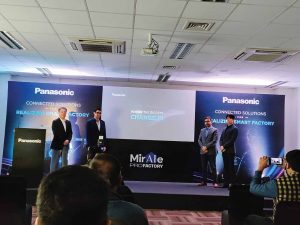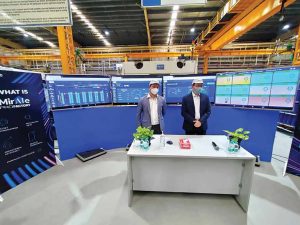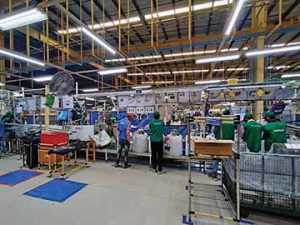Panasonic India showcased the MirAIe (Miraie) Pro factory platform, an Industrial IoT/ smart factory solution developed indigenously at the company’s India Innovation Centre. Miraei is compatible with different types of machines, models and brands in the automotive manufacturing space. The next-generation solution is aimed at facilitating Indian manufacturers to in turn digitise their operations and allow enterprises to realise the true potential of Industry 4.0. Manish Sharma, Chief Executive Officer (CEO) at Panasonic India mentioned, “Smart factories are strategic business investments. They are helping manufacturers jump start their digital journey, offer a competitive edge, innovate and improve the Overall Equipment Effectiveness (OEE) while saving major costs.” Miraie uses new-age technologies such as Cloud, Internet of Things (IoT), analytics and a mobile app., to name a few. Through Miraie, manufacturers can look forward to managing end-to-end operations that are claimed to result in enhanced production efficiencies and quality levels along with helping Original Equipment Manufacturers (OEMs) identify inherent issues. This is expected to result in lower downtime occurrences. On helping manufacturers break even, it is also said to be a good starting point to attain economies of scale. The solution is currently available in four variants and is customisable. From basic to advanced, depending on the requirement with bundled, value-added features.
The building blocks
Ahead of the showcase, Panasonic India conducted several pilot projects. Claimed Sharma that the use of Miraie had resulted in an increase of about eight to 15 per cent in productivity at the manufacturing facility where Miraie was tested. The Miraie platform aims at empowering enterprises especially those looking at making the switch to digital. Developed indigenously at the company’s India Innovation Centre, to make it appealing for manufacturers, the company has priced it competitively as per Sharma. “It’s competitive in terms of pricing, and since it’s a solution the price varies from the demand and features added to the platform,” he explained on being asked to pin point a ballpark estimate on its acquisition. Sharma drew attention to Miraie as an outcome of Panasonic’s strong industrial know-how and expertise in manufacturing.
Key USPs
Miraie aids in data collection from any machine by connecting to the gateway. The software on the gateway processes data from the machine in real-time and streams this data securely on to the cloud. One can visualise machine performances remotely and enable operators to meet the production goals by foreseeing potential hindrances thereby making production seamless. Asset management, machine monitoring, real-time machine condition relay, KPI dashboards, operator view, alerts and notification, and production planning are among the key USPs of the smart factory.
Sharma mentioned that the platform’s key USPs include quick deployment, an easy to use interface and offers scalability. The data is made available in real-time and eliminates time-consuming data tag mapping. He added that the solution drives immediate value with an out of the box approach and does not require any initial set up making it a near plug and play platform. This helps the operator free resources to focus on better decision-making for a particular point in time. The information provided by the platform comes from an internal assessment of the digital factory. Masafumi Himeno, Divisional Managing Director, Panasonic Smart Factory Solutions India averred, “Panasonic Smart Factory Solutions India (PSFSIN) facility in Haryana is strategically aligned with the Government’s ‘Make-In-India’ and ‘Skill India’ initiatives.” Further, he explained that the advancement in wireless technology (for example with 5G) will drive greater adoption of cutting-edge technology at manufacturing facilities across the country, in the future. Panasonic India, as per Himeno, is aiming to empower Indian origin as well as global manufacturers looking for a connected shop floor and an ecosystem powered by new-age technologies that help manage end-to-end operations with the help of a better shopfloor visualisation. It is claimed to ensure a viable blend of enhanced production efficiency, quality, and reduced downtime to help build on the economies of scale.
Addressing pain points
Plant managers have had it tough in the pandemic! A few challenges faced by plant managers while implementing strategies for successful maintenance of production equipment include being unable to scout glitches or tackle unreported downtimes. Difficulty in gauging historical data and manual bias apart from the lack of ability to monitor overall equipment efficiency add to the layers of complexity. Now, these challenges can be eradicated by adopting digital solutions, but they come with their own set of collateral. To start with, it is a high upfront investment along with customisation requirements as mentioned before. There is a need to create small in-house IT departments and with it comes the prerequisites of energy and resource required for a phased modular approach. Miraie assists manufacturers and OEMs in being more efficient while making the shopfloor paperless. It aids in gathering machine comparisons across the shop floor, diagnosing error patterns and coming up with suggestions to solve the problem. It increases machine effectiveness along with offering predictive maintenance warnings for the equipment used in the factory and is claimed to maximise the overall plant or factory output.

The integrated view can be relayed from any system to smartphones and tablets. It also has a provision of segregated log ins and an operating interface for levels of staff on the shopfloor. This differentiates how a problem is approached and how only the concerned authorities are notified. Manish Misra, Chief Technology Officer, Panasonic India Innovation Centre said, “Miraie Pro Factory is a one-stop solution for deployment, service and business intelligence needs. It empowers manufacturers to design paperless digitised shop floors, drives machine effectiveness, maximises plant operations i.e., monitor production efficiencies right from procurement to finished assembly.” He explained how the IIoT solution from Panasonic enhances the capabilities through vertical integration i.e. hardware and software to converge Operation Technology (OT) and Information Technology (IT) to offer a single comprehensive view. Data analytics further enhances the OEE by providing real-time insights allowing enterprises to optimise assembly units faster and efficiently through predictive maintenance, real-time monitoring, and quality management processes. Remote monitoring through mobile, one dashboard for all operations with a unique UI are some of the additional features that aid in automation and ensuring contact less management.”
Miraie was made to cater to the needs of India’s manufacturing industry offering the best blend of Japanese technologies. Manufacture of welding machines, digital solutions, or solutions like robotic welding thus driving the nation towards self-reliance. Further, the PSFSIN division at Panasonic India’s manufacturing facility is one of the largest producers of manual welding equipment in India catering to the demand arising from automobiles among other sectors. Ever since the pandemic in 2020, SMEs along with big-time players have been pushed to the corner and compelled to adapt to the new normal of digitalisation. Key automobile manufacturers took it in their stride and launched digital platforms to conduct sales and service of their products. These platforms were also used to offer lucrative schemes to create a pull.
While the front end was quicker to digitise, the back end and the shopfloor awaited their transformation. It gave birth to digital solutions like Dassault’s DW Suite and MirAIe to name a few. The application of such platforms is to curb the presence of people on the shop floor or offer tools for human-machine collaboration to in turn help manufacturers turn more efficient and attain their objectives. Not that these were far away from being integrated into the systems, Covid19 accelerated the switch. Solutions like Miraie are expected to continue to play a pivotal role in manufacturing especially with viruses giving rise to mutations that could stall the global economy. Supply chains continue to be weighed down by challenges with recurring crests and troughs making it a volatile environment for automotive suppliers. Miraie looks promising with its next-generation capabilities. ACI
Feature Function
Asset management Remotely manage machines and networking
Machine monitoring Relay machine schematics to help assess improvement areas
Real-time machine condition Monitor machine parameters for necessary intervention
KPI Dashboards Relay machine status and production efficiency in an easy GUI
Operator view Add human-context to machine data with a portable tablet app.
Alerts and notifications Customisable notifications and audit trackable, flexible workflows
Production planning Production planner at the machine level















Leave a Reply